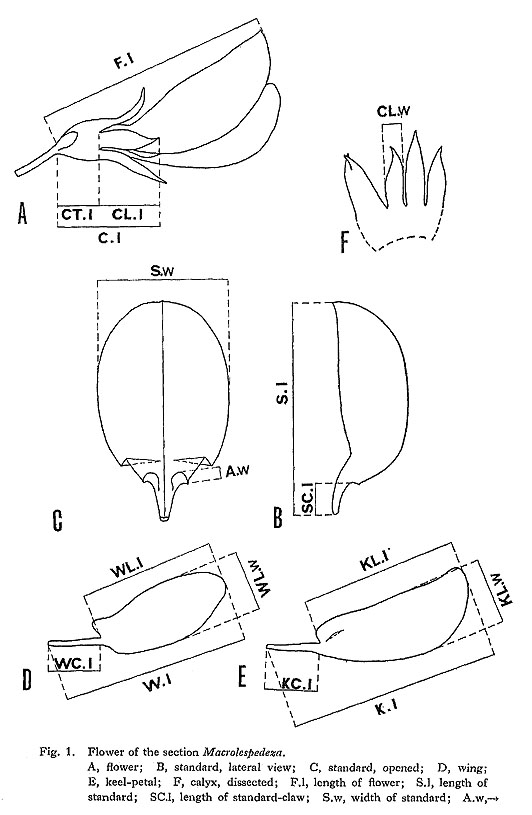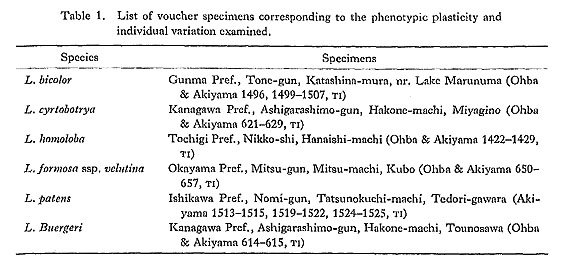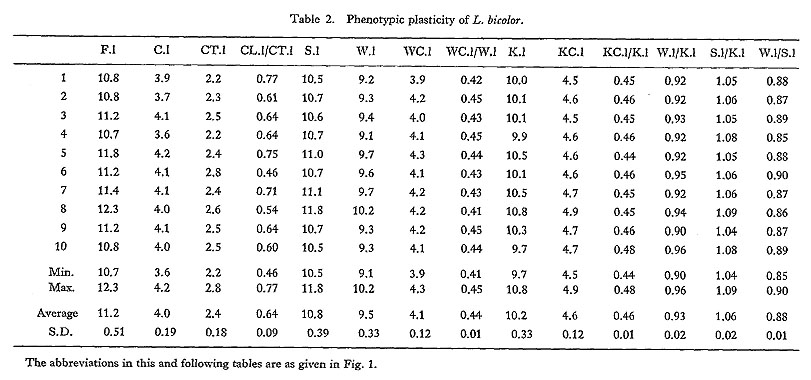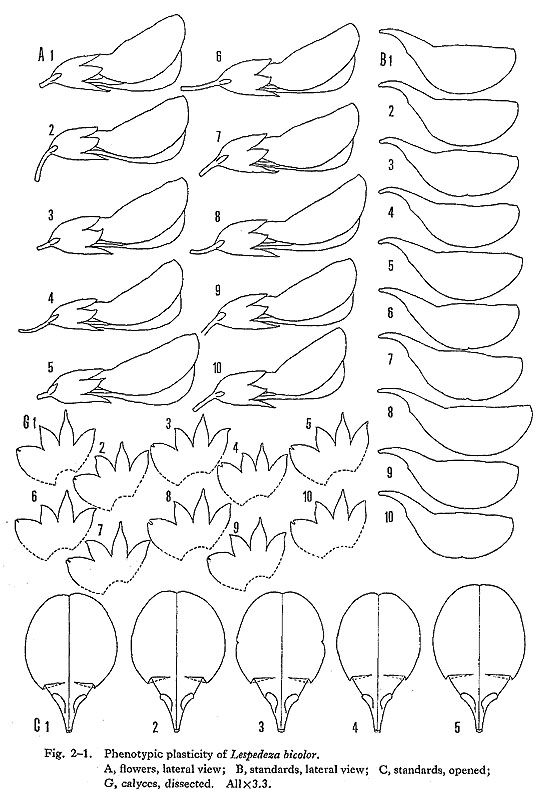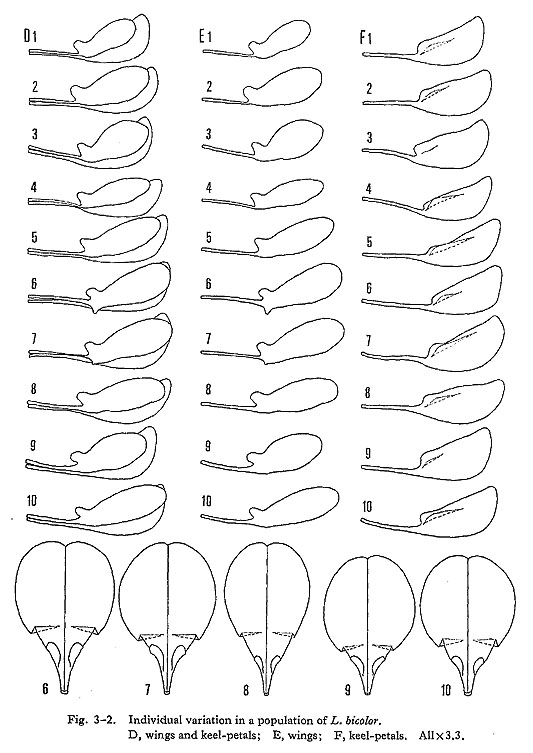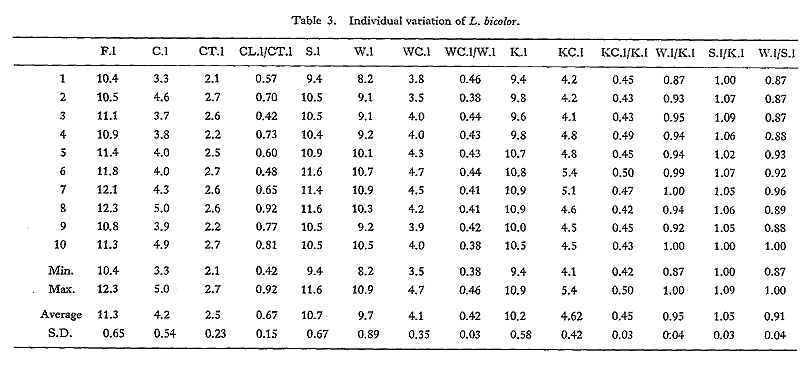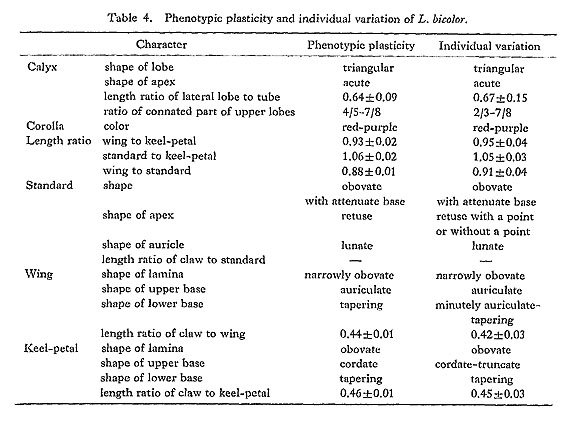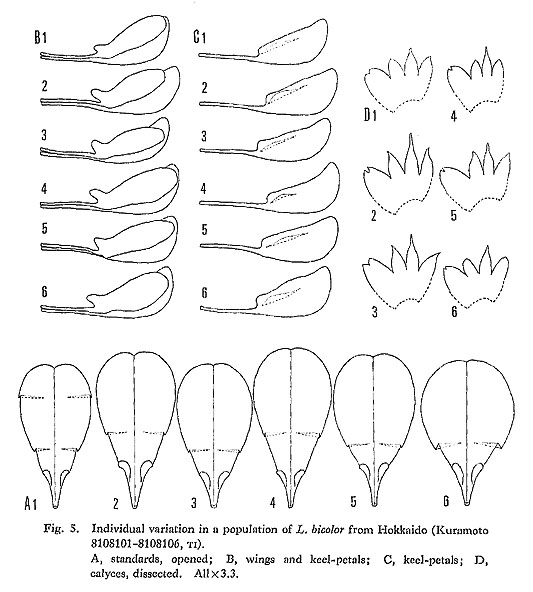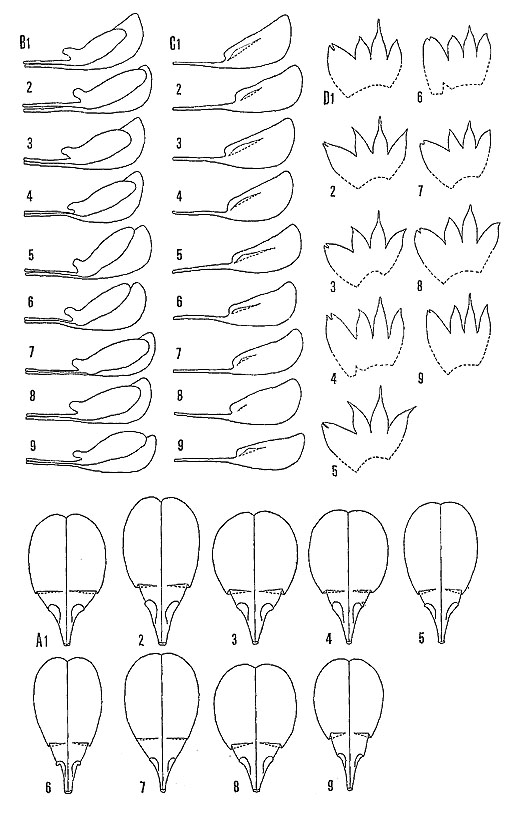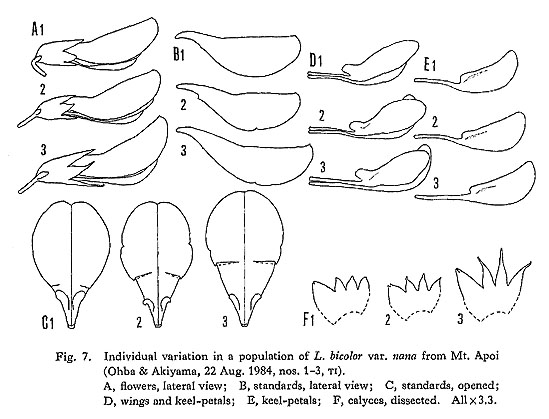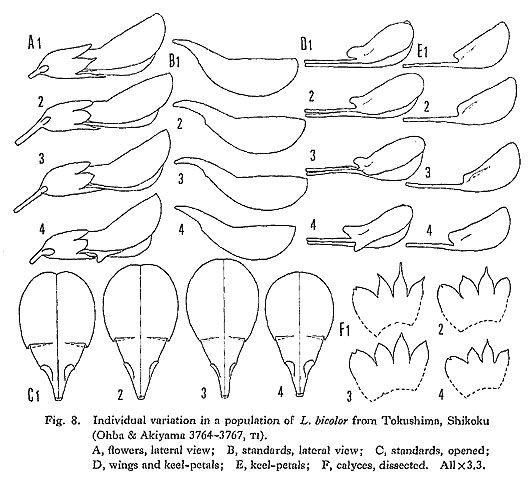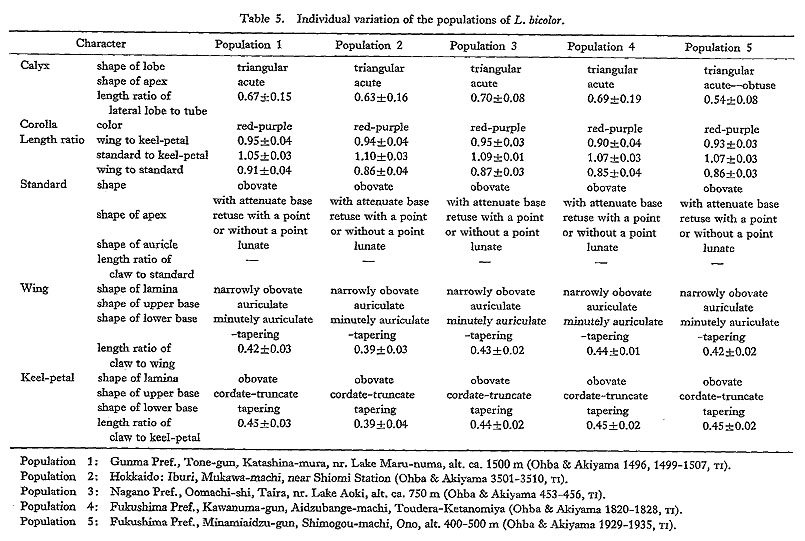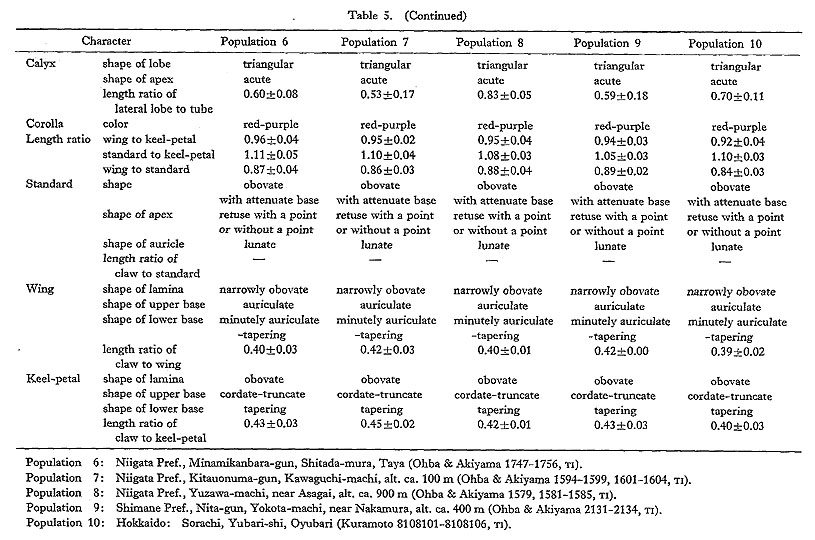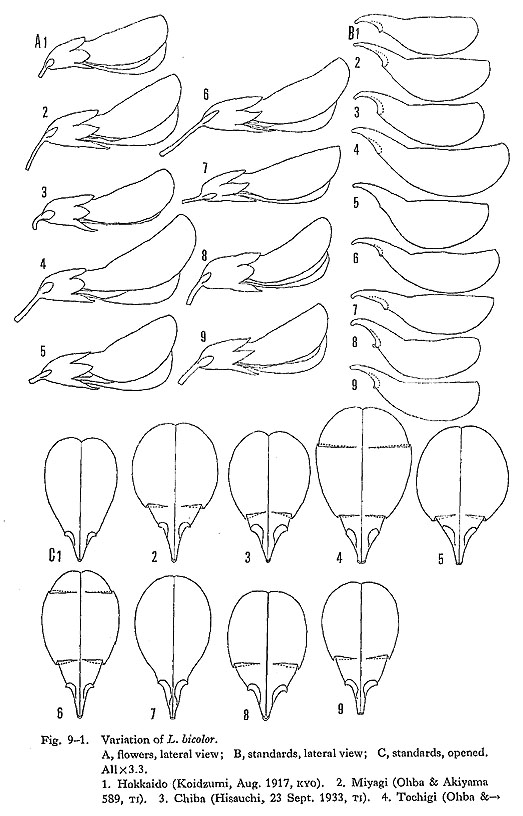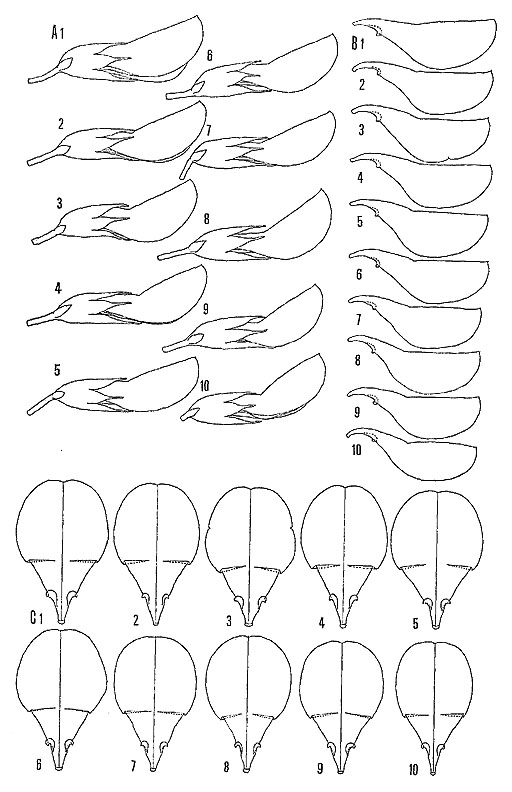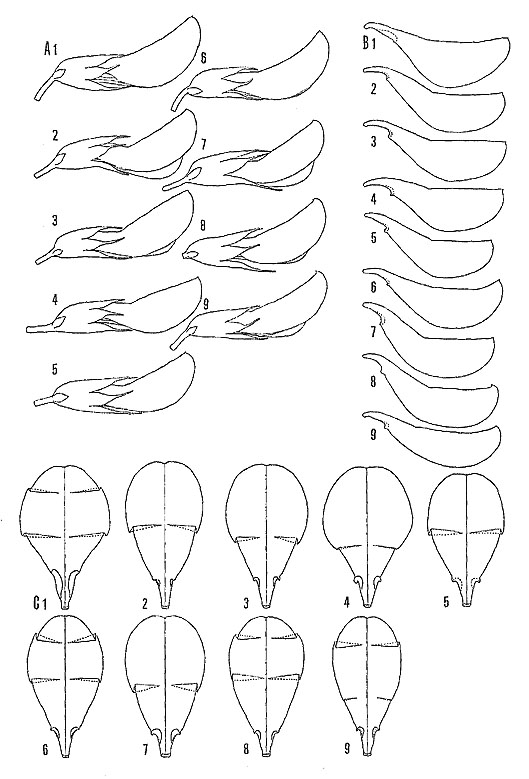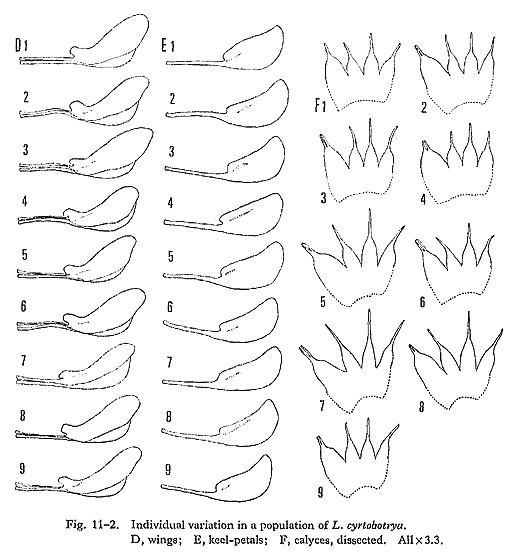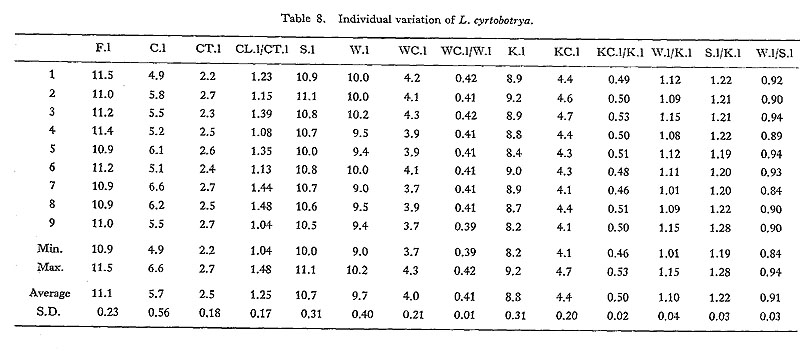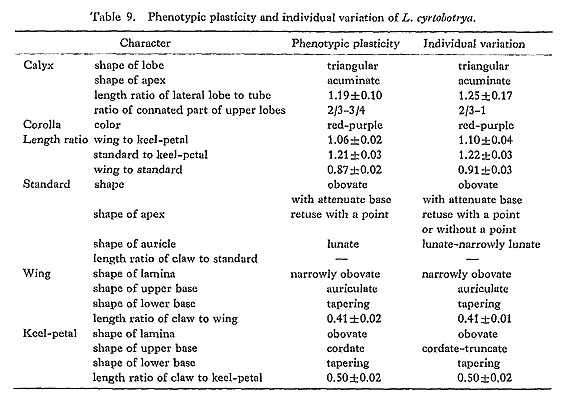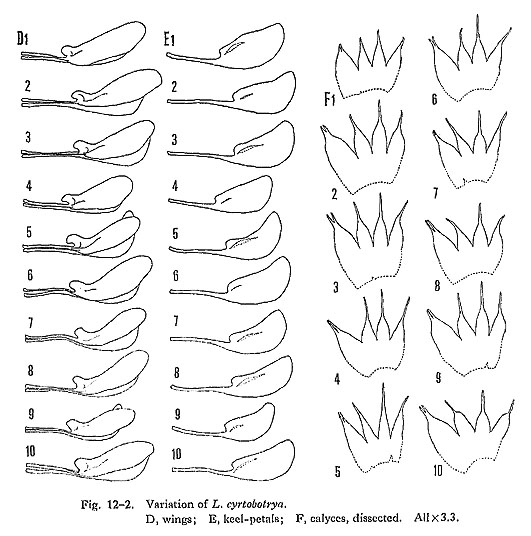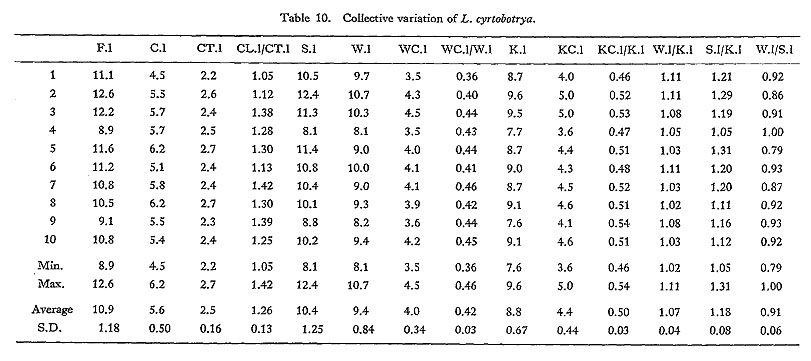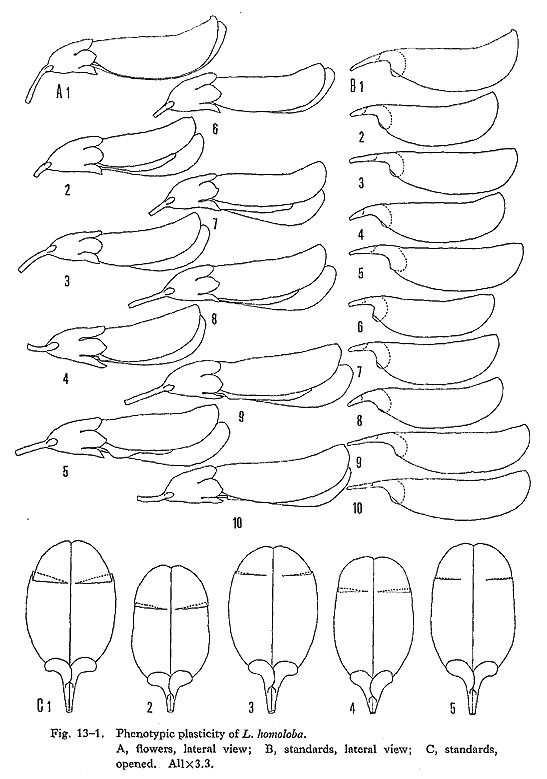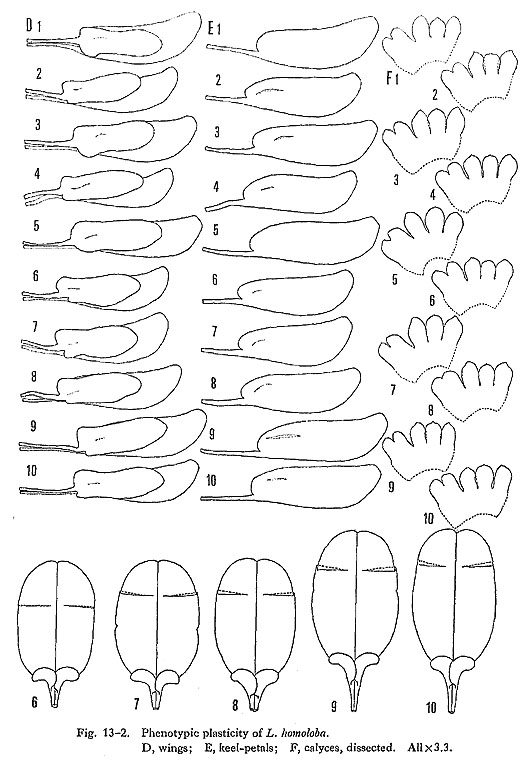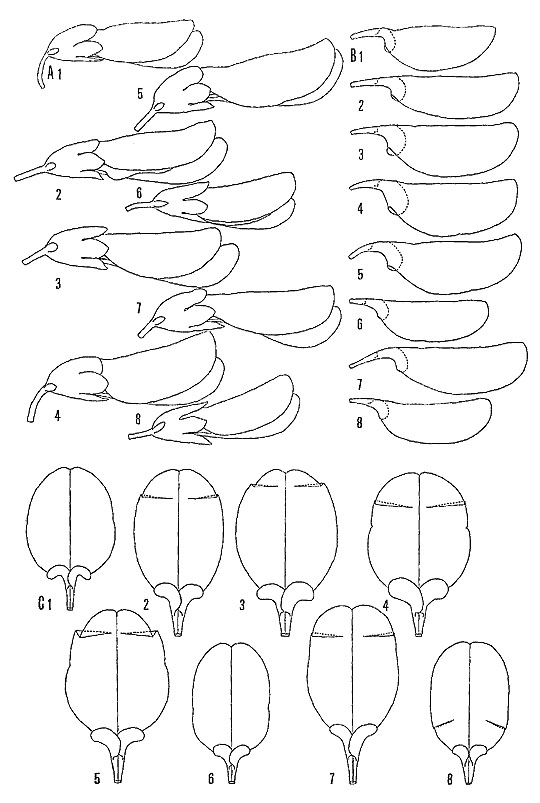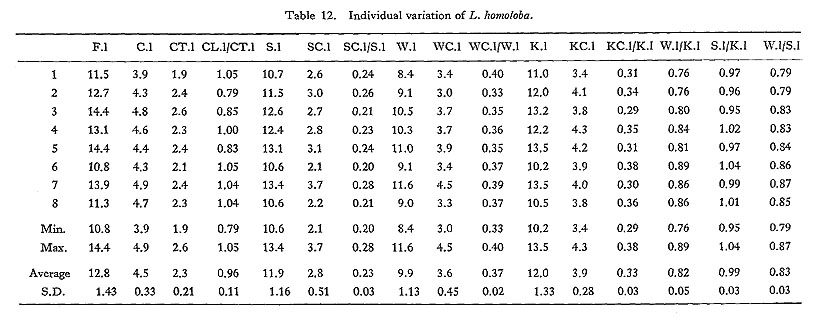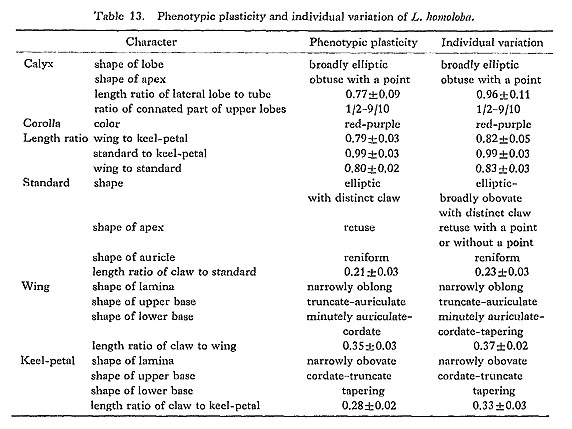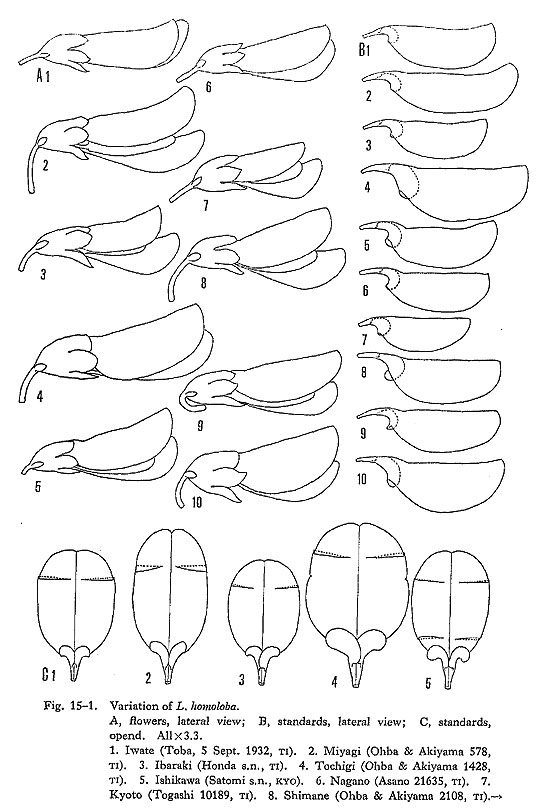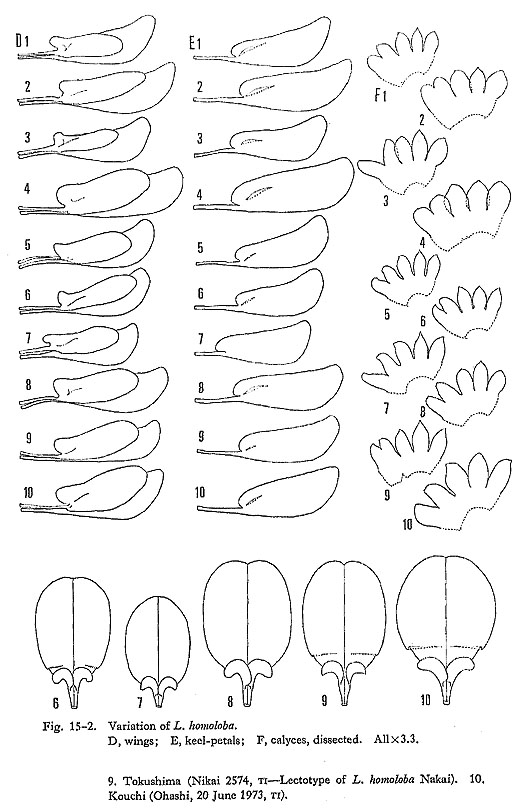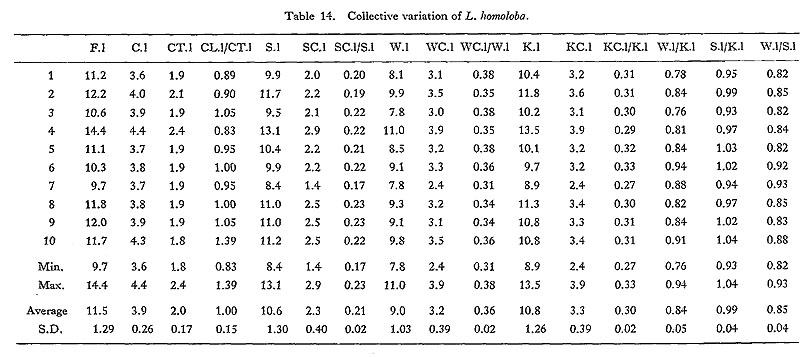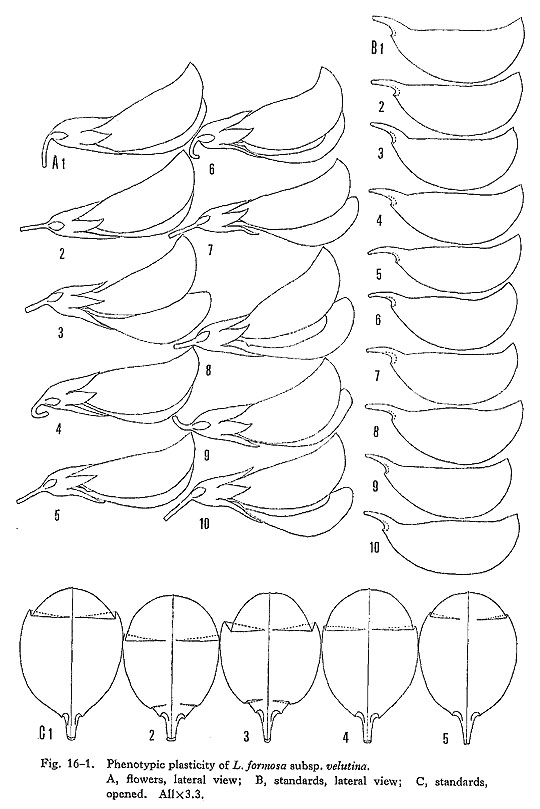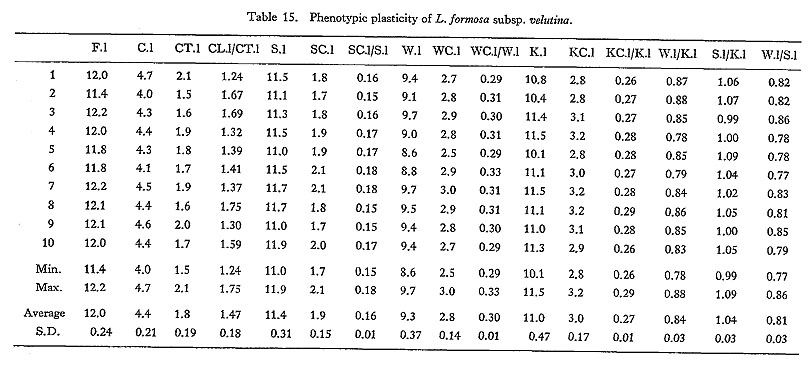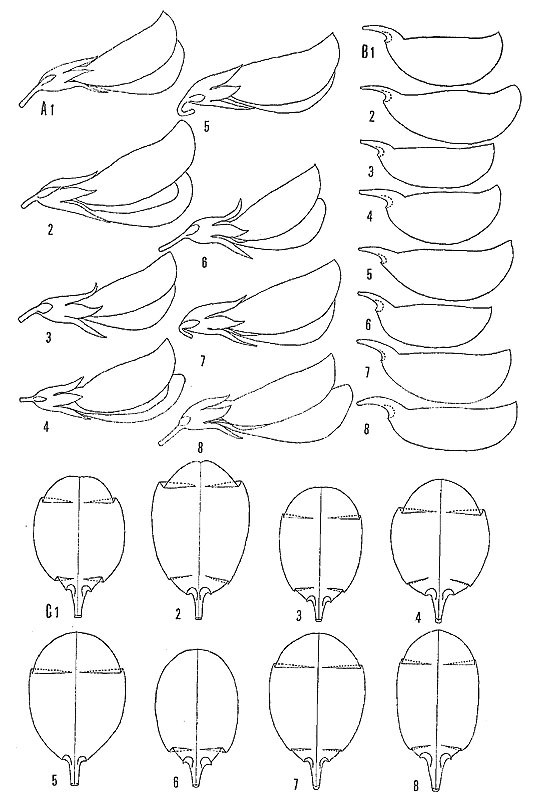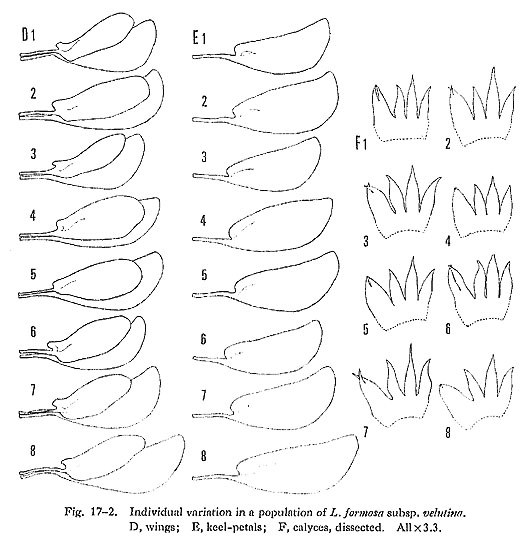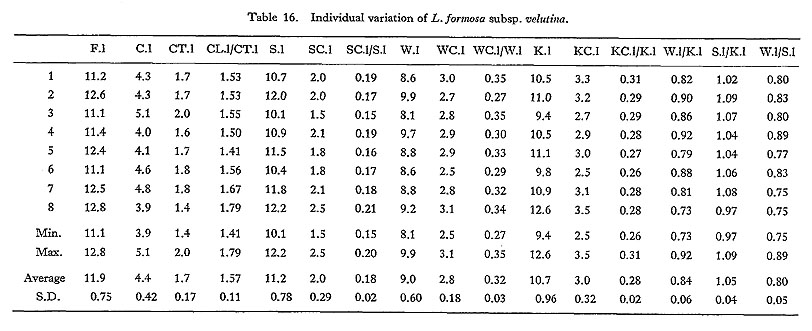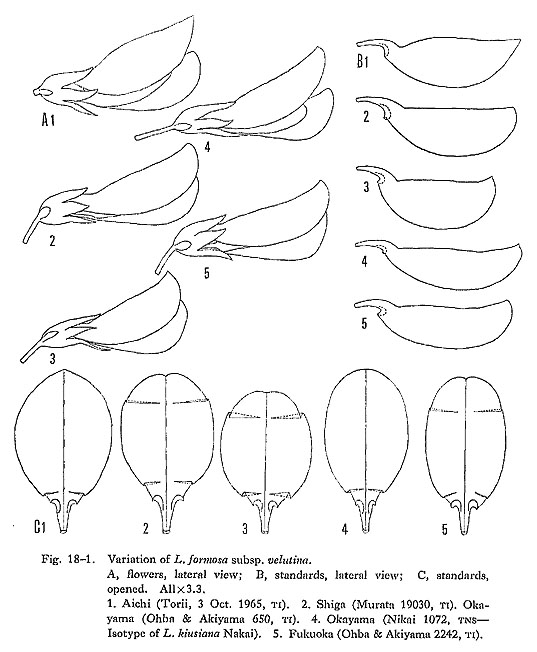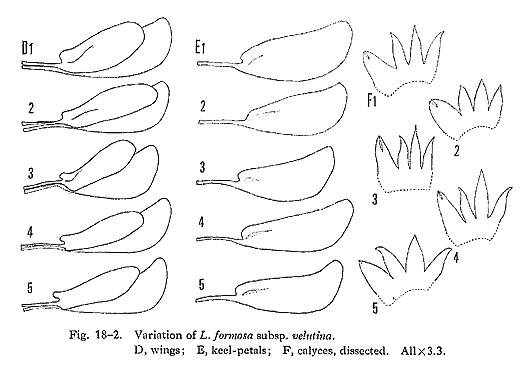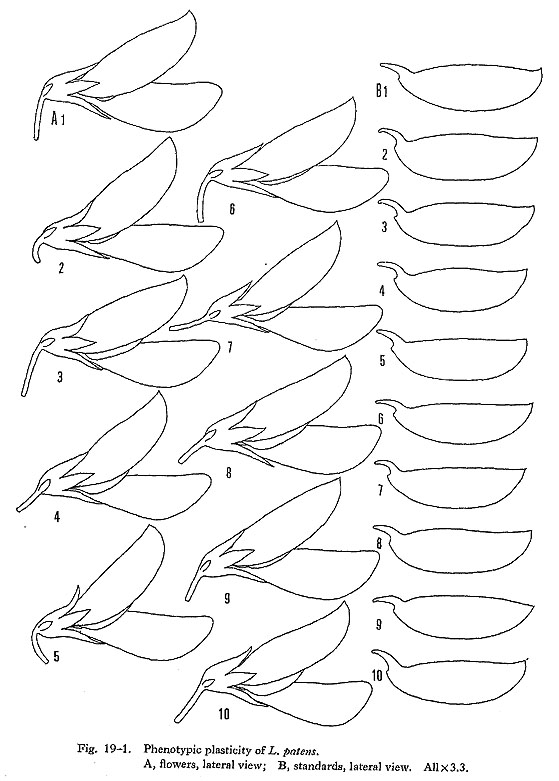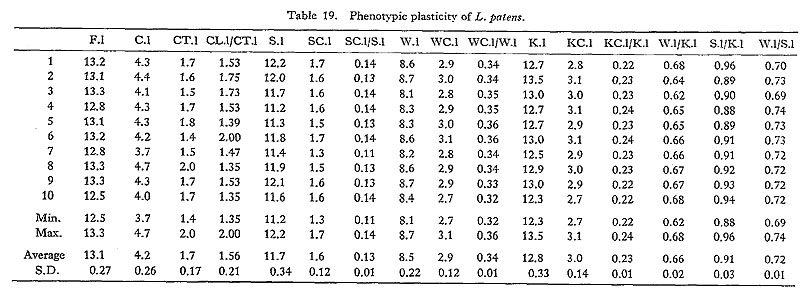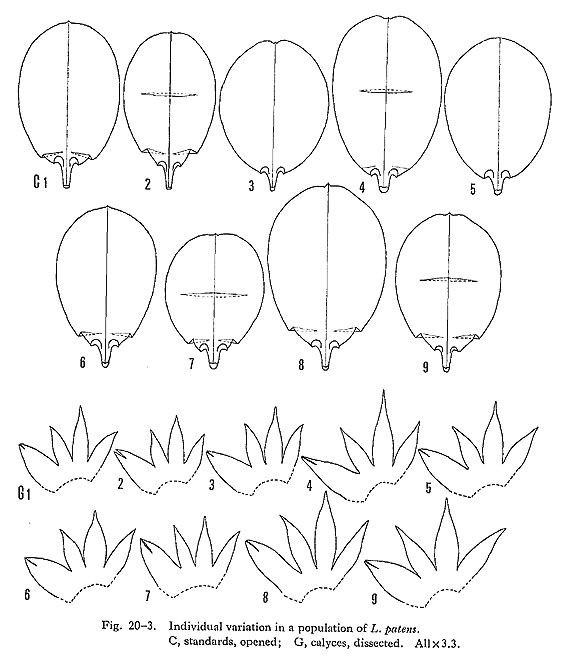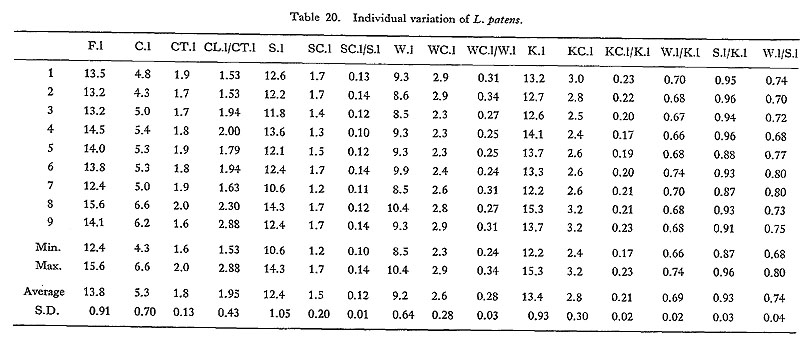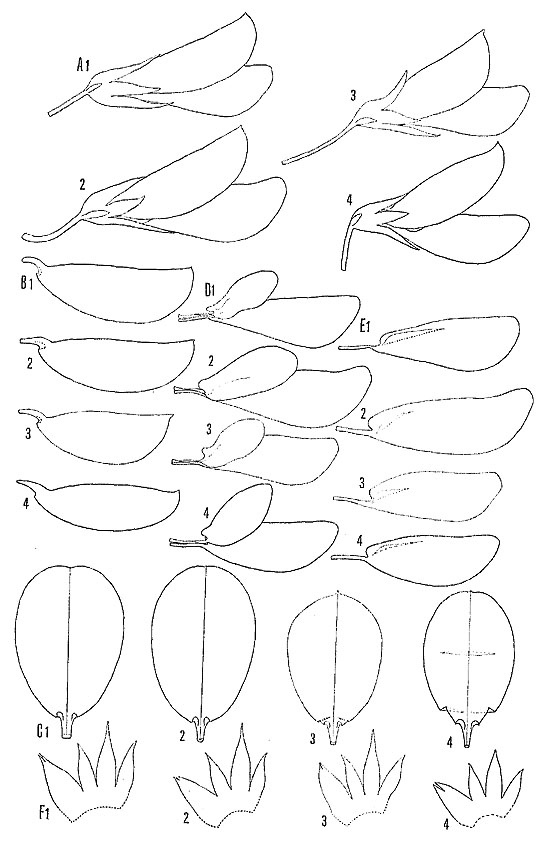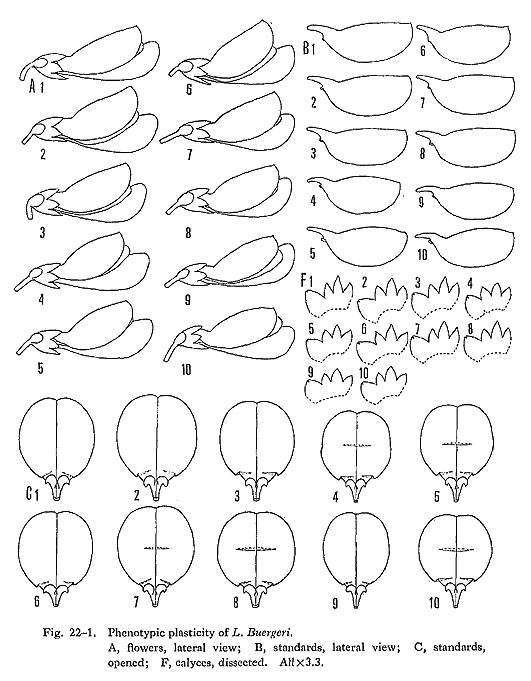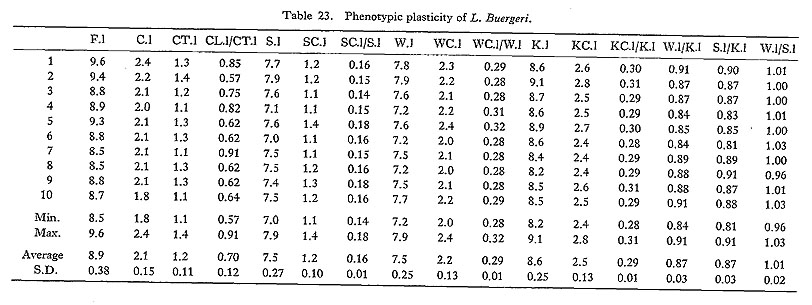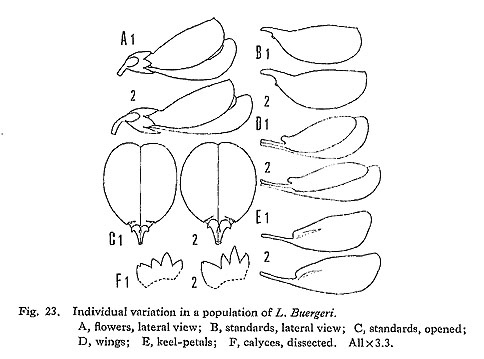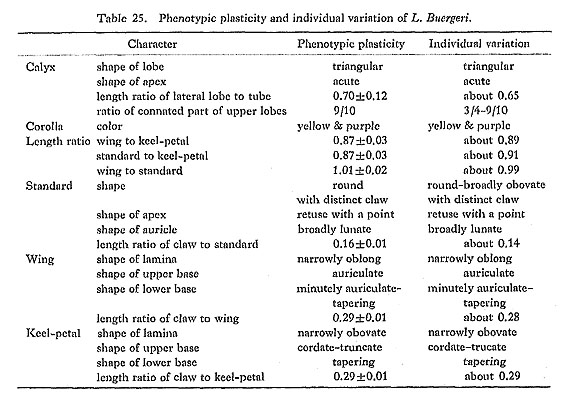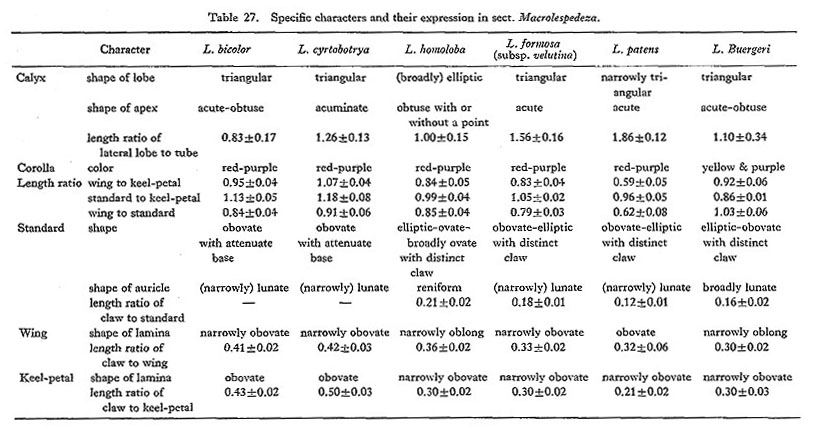Morphological Diversity and Variation
Floral Characters
|
Generally floral features are regarded as the most reliable characters for species delimitation, although in sect. Macrolespedesa the floral features have not been fully investigated. Variation is due to genetically inherited differences or to a particular range of environmental factors which produce largely reversible modifications from the same genotype. It is not possible to determine the nature of the variation-whether genotypic or environmentally induced-in the herbarium or even in the field (Davis & Heywood, 1973). However, the variation seen among many flowers from a single individual is environmentally induced and regarded as phenotypic plasticity. Variation in terms of populations can be divided into individual and collective variation. Individual variation, including phenotypic plasticity, occurs among individuals within a population, while collective variation occurs between populations. We have attempted to clarify phenotypic plasticity and individual and collective variations of various floral features to determine reliable floral characters for taxonomic purposes. The field survey was carried out in Japan and Hong Kong. Collections were made from one or more populations at each locality. All specimens collected were deposited in the Herbarium, Department of Botany, University Museum, University of Tokyo (TI). This study is also based on herbarium specimens deposited in various herbaria, as mentioned in the Introduction. Measurements and sketches were based on fully developed flowers. Flowers taken from herbarium specimens were examined under a binocular microscope with camera lucida after boiling in water. Measurements were made of the morphological features shown in Fig. 1.
Both phenotypic plasticity and individual variation of each species were investigated based on six populations of six species, which are widely distributed in Japan (Table 1). Ten fully developed flowers were taken from a single individual within a population and dissected. To investigate individual variation, a single flower was taken from all individuals constituting a population. To study variation between populations (i.e., collective variation), ten populations of L. bicolor Turcz. from various localities were investigated. Moreover, in five other species one flower from each individual in various localities was investigated.
Observation Phenotypic plasticity: Ten flowers are illustrated in Fig. 2 and sizes of each floral character are summarized in Table 2. The standard is apparently longer than the wing and the keel-petal (Fig. 2A). The wing is shorter than the keel-petal (Fig. 2D). The ratio of the length of the standard to the keel-petal is 1.06±0.02, wing to standard 0.88±0.01, and wing to keel-petal 0.93±0.02.
The shape of the standard is obovate with an attenuate base and a retuse apex; the shape of the auricle is lunate (Fig. 2B & C). The shape of the lamina of the wing is narrowly obovate with an auriculate upper base and tapering lower base (Fig. 2E). The ratio of the length of the wing-claw to the wing is 0.44±0.01. The shape of the lamina of the keel-petal is obovate with a cordate upper base and tapering lower base (Fig. 2F). The ratio of the length of the keel-petal-claw to the keel-petal is 0.46±0.01. The shape of the lateral calyx-lobe is triangular with an acute apex (Fig. 2G). Two upper calyx-lobes are connated 4/5-7/8 of the way along its length. The calyx-lobes are apparently shorter than the tube, and the ratio of the length of the lateral calyx-lobe to the calyx-tube is 0.64±0.09. Individual variation: The population studied consisted of nine blooming individuals (Fig. 3; Table 3). Almost all characters that have constant expressions in phenotypic plasticity are stable within this population (Table 4). However, the lower base of the lamina of the wing varies from tapering to minutely auriculate and the upper base of the lamina of the keel-petal also varies from cordate to truncate. Two upper calyx- lobes are connated 2/3-7/8 of the way along its length. The length ratios between different petals or parts of petals show a slightly wider range of variation than those in phenotypic plasticity (Table 4). That is, the ratio of the length of the standard to the keel-petal is 1.05±0.03, wing to standard 0.91±0.04, wing to keel-petal 0.95±0.04, wing-claw to wing 0.42±0.03, keel-petal-claw to keel-petal 0.45±0.03, and lateral calyx-lobe to calyx-tube 0.67±0.15.
Collective variation: The flowers from three of ten representative populations from various localities are illustrated in Figs. 4-6 and the individual variations of characters within each population are summarized in Table 5. Most of the characters with constant expression in both phenotypic plasticity and individual variation also exhibit constant expression in these ten populations. A slight difference in expression of some characters was observed in the population from Mt. Apoi, Hokkaido (Fig. 7).* In this population the wing is slightly longer than or nearly equal to the keel-petal. Most populations from Shikoku also exhibit a slight difference in expression of the relative length between the wing and the keel-petal (Fig. 8). The wing is slightly longer than or nearly equal to the keel-petal. Therefore var. nana and the population from Shikoku are excluded from the further observations described below.
The wing is usually shorter than the keel-petal but rarely is the same as the keel-petal in length. The auricles of standard vary from lunate to narrowly lunate. The shape of the base of the wing lamina is more variable. The apices of the lateral calyx-lobes arc variable from acute to obtuse. The ratio of the length of the wing to the keel-petal is 0.90(±0.04)-0.96(±0.04), standard to keel-petal 1.05(±0.03)-1.11 (±0.05), wing to keel-petal 0.84(±0.03)-0.91(±0.04), wing-claw to wing 0.39 (±0.03)-0.44(±0.01), keel-petal-claw to keel-claw 0.39(±0.04)-0.45(±0.03), and lateral calyx-lobe to calyx-tube 0.53(±0.17)-0.83(±0.05). Flowers from various localities are shown in Fig. 9 and Table 6. The expression of each character does not exceed the range of variation of those among the ten populations mentioned above.
Phenotypic plasticity: Ten flowers are illustrated (Fig. 10) and measured (Table 7). The standard is significantly longer than the wing and the keel-petal (Fig. 10A), and the wing itself is apparently longer than the keel-petal (Fig. 10D). The ratio of the length of the standard to the keel-petal is 1.21±0.03, wing to standard 0.87±0.02, and wing to keel-petal 1.06±0.02 (Table 7).
The shape of the standard is obovate with an attenuated base like that of L. bicolor, with or without lateral notches. The apex is retuse with a point (Fig. 10B & C). The shape of the auricle near the base of the standard is lunate. The shape of the lamina of the wing is narrowly obovate with an auriculated upper base and tapering lower base (Fig. 10D). The ratio of the length of the wing-claw to the wing is 0.41±0.02. The shape of the lamina of the keel-petal is obovate with a cordate upper base and tapering lower base (Fig. 10E). The ratio of the length of the keel-petal-claw to the keelpetal is 0.50±0.02. The shape of the lateral calyx-lobe is triangular with a fine acuminate apex (Fig. 10F). Two upper calyx-lobes are connated 2/3-3/4 of the way along its length. The calyx-lobes are apparently longer than the tube and the ratio of the length of the lateral calyx-lobe to the calyx-tube is 1.19±0.10. Individual variation: A population consisting of nine blooming individuals was investigated (Fig. 11 and Table 8). As in the case of L. bicolor almost all of the characters with constant expressions phenotypically are stable within this population (Table 9). However, some characters become slightly more variable in expression: in the standard, the auricle varies from lunate to narrowly lunate, and the apex also varies from retuse with a point to retuse without a point (Fig. 11C). The upper base of the lamina of the keel-petal is cordate or truncate (Fig. 11F).
The ratios of the length of each petal show a wider range of variation, but the standard is always longer than the other petals and the wing is longer than the keel-petals (Table 9). That is, the ratio of the length of the wing to the keel-petal is 1.10±0.04, standard to keel-petal 1.22±0.03, wing to standard 0.91±0.03, wing-claw to wing 0.41±0.01, keel-pctal-claw to keel-petal 0.50±0.02, and lateral calyx-lobe to calyx-tube 1.25±0.17. Two upper calyx-lobes are connated 2/3 to the entire way along its length (Fig. 11F). Collective variation: Flowers from various localities were illustrated (Fig. 12) and measured (Table 10). The expressions of the characters investigated do not exceed the variation range of those within the single population mentioned above. The relative length among various characters is slightly different from that in the single Opopulation.
Phenotypic plasticity: Ten flowers are illustrated in Fig. 13 and the measurement of each character is summarized in Table 11. The standard is nearly equal to or slightly shorter than the keel-petal (Fig. 13A), while the keel-petal is longer than the wing (Fig. 13D). The ratios of the length of each petal are summarized in Table 11. That of the standard to the keel-petal is 0.99±0.03, wing to standard 0.80±0.02, and wing to keel-petal 0.79±0.03.
The standard has a distinct claw; the shape of the lamina of the standard is elliptic with a refuse apex, with or without lateral notches; the auricle at the base of the lamina is well developed and its shape is reniform (Fig. 13B & C). The ratio of the length of the standard-claw to the standard itself is 0.21±0.03. The shape of the lamina of the wing is narrowly oblong with a truncate or auriculate upper base and a minutely auriculate or cordate lower base (Fig. 13D). The ratio of the length of the wing-claw to the wing itself is 0.35±0.03. The shape of the lamina of the keel-petal is narrowly obovate with a cordate upper base and a tapering lower base (Fig. 13E). The ratio of the length of the keel-petal-claw to the keel-petal is 0.28±0.02. The shape of the lateral calyx-lobe is elliptic; the apex is obtuse with a point (Fig. 13 F). Two upper calyx-lobes are connated 1/2-9/10 of the way along its length. The calyx-lobes are shorter than the tube and the ratio of the length of the lateral calyx-lobe to the tube is 0.77±0.09. Individual variation: A population consisting of eight blooming individuals was investigated (Fig. 14 and Table 12). As in the former two cases almost all of the characters with constant expressions phenotypically are stable within this population, although some become slightly more variable (Table 13). The ratio of the length of the standard to the keel-petal is 0.99±0.03, wing to standard 0.83±0.03, and wing to keel-petal 0.82±0.05.
The shape of the lateral calyx-lobe is broadly elliptic to elliptic (Fig. 14C). Two upper calyx-lobes are connated 1/2-9/10 of the way along its length. The length of the calyx-lobes varies from shorter than the tube to nearly the same. The ratio of the length of the lateral calyx-lobe to the tube is 0.96 ± 0.11. Collective variation: Flowers from various localities were illustrated (Fig. 15) and measured (Table 14). The expressions of the characters investigated scarcely exceed the variation range of those in the single population mentioned above. The relative length among various characters is slightly different from that in the single population. However, the shape of the standard was much variable, from elliptic to obovate to broadly obovate (to ovate) (Fig. 15C). The upper and lower bases of wing also have increased variation in shape (Fig. 15D). The shape of the lateral calyx-lobe varies from broadly elliptic to elliptic. The apex of the lateral calyx-lobes is obtuse with or without a point (Fig. 15F).
S. Akiyama et H. Ohba Phenotypic plasticity: Ten flowers were illustrated (Fig. 16) and measured (Table 15). The standard is nearly equal to or slightly longer than the keel-petal (Fig. 16A). The keel-petal is longer than the wing (Fig. 16D). The ratio of the length of the standard to the keel-petal is 1.04 ± 0.03, wing to standard 0.81 ± 0.03, and wing to keel-petal 0.84 ± 0.03 (Table 15).
The standard has a distinct claw; the shape of the lamina of the standard is obovate, the apex is retuse with a point, and the shape of the auricle at the base of the lamina is narrowly lunate (Fig. 16B & C). The ratio of the length of the standardclaw to the standard itself is 0.16 ± 0.01. The shape of the lamina of the wing is narrowly obovate with a slightly auriculate or cordate upper base and a minutely auriculate or tapering lower base (Fig. 16D). The ratio of the length of the wing-claw to the wing itself is 0.30 ± 0.01. The shape of the lamina of the keel-petal is narrowly obovate with a cordate upper and tapering lower base (Fig. 16E). The ratio of the length of the keel-petal-claw to the length of the keel-petal is 0.27 ± 0.01. The shape of the lateral calyx-lobe is triangular-lanceolate with an acute apex (Fig. 16F). Two upper calyx-lobes are connated 2/3-3/4 of the way along its length. The calyx-lobes are apparently longer than the tube, and the ratio of the length of the lateral calyx-lobe to the tube is 1.47 ± 0.18. Individual variation: A population consisting of eight blooming individuals was investigated (Fig. 17 and Table 16). As in the former cases almost all of the characters with constant expressions in phenotypic plasticity are stable within this population, but some characters become slightly more variable (Table 17).
The standard is slightly longer or, rarely, slightly shorter than the keel-petal (Fig. 17A). The ratio of the length of the standard to the keel-petal is 1.05 ± 0.04, wing to standard 0.80 ± 0.05, and wing to keel-petal 0.84 ± 0.06. The shape of the auricle of the standard varies from narrowly lunate to lunate (Fig. 17C). The ratio of the length of the standard-claw to the standard itself is 0.18 ± 0.02. The shape of the upper base of the wing lamina is auriculate or truncate (Fig. 17D). The ratio of the length of the claw to the wing itself is 0.32 ± 0.03. The shape of the upper base of the lamina of the keel-petal is cordate or truncate (Fig. 17E). The ratio of the length of the claw to the keel-petal itself is 0.28 ± 0.02. The shape of the lateral calyx-lobe is triangular to triangular-lanceolate (Fig, 17F). Two upper calyx-lobes are connated 1/3 to the entire way along its length. The ratio of the length of the lateral calyx-lobe to the tube is 1.57 ± 0.11. Collective variation: Flowers from various localities were illustrated (Fig. 18) and measured (Table 18). The expressions of the characters investigated do not exceed the range of variation of those in the single population mentioned above. The relative length among various characters is slightly different from that in the single population (Table 16); in particular, the relative length between the standard and the keel-petal becomes variable: the former is slightly longer than, nearly equal to, or slightly shorter than the latter.
The lamina of standard varies from obovate to elliptic (Fig. 18C). The shape of the lamina base of wing is rather variable. The shape of the lamina of the keel-petal is narrowly obovate with a tapering lower base (Fig. 18E). The shape of the upper base of the keel-petal-lamina becomes variable. Phenotypic plasticity: Ten flowers were investigated (Fig. 19 and Table 19). The standard is shorter than the keel-petal (Fig. 19A), and the wing is shorter than the keel-petal and the standard (Fig. 19D). The ratio of the length of the standard to the keel-petal is 0.91 ± 0.03, wing to standard 0.72 ± 0.01, and wing to keel-petal 0.66 ± 0.02.
The standard has a distinct claw; the shape of the lamina is obovate and the apex is truncate with a point (Fig. 19C & D). The shape of the auricle is lunate. The ratio of the length of the claw to the standard itself is 0.13 ± 0.01. The shape of the lamina of the wing is obovate with an auriculate or cordate upper base and a minutely auriculate or cordate lower base (Fig. 19E). The ratio of the length of the claw to the wing itself is 0.34 ± 0.01. The shape of the lamina of the keel-petal is narrowly obovate with a truncate or cordate upper apex and tapering lower base (Fig. 19F). The ratio of the length of the claw to the keel-petal itself is 0.23 ± 0.01. The shape of the lateral calyx-lobe is narrowly triangular with an acute apex in all flowers (Fig. 19G). Two upper calyx-lobes are connated 2/3-7/8 of the way along its length. The calyx-lobes are apparently longer than the tube; the ratio of the length of the lateral calyx-lobe to the tube is 1.56 ± 0.21. Individual variation: The population studied consisted of nine blooming individuals (Fig. 20 and Table 20). As in previous cases almost all characters with constant ex pressions in phenotypic plasticity are also stable within this population, although some become slightly variable (Table 21). The ratio of the length of the standard to the keel-petal is 0.93 ± 0.03, wing to standard 0.74 ± 0.04, and wing to keel-petal 0.69 ± 0.02 (Table 21).
In the standard, the shape of the lamina varies from obovate to elliptic, the apex varies from truncate with a point to obtuse, and the auricle varies from lunate to narrowly lunate (Fig. 20B & C), The ratio of the length of the claw to the standard itself is 0.12 ± 0.01. The shape of the base of the wing lamina is also variable (Fig. 20E). The ratio of the length of the claw to the wing itself is 0.32 ± 0.06. The shape of the upper base of the lamina of the keel-petal varies from cordate to truncate (Fig. 20F), and the ratio of the length of the claw to the keel-petal itself is 0.21 ± 0.02. Two upper calyx-lobes are connated 2/3-7/8 of the way along its length (Fig. 20G). The ratio of the length of the lateral calyx-lobe to the tube is 1.95 ± 0.43. Collective variation: Flowers from various localities were illustrated (Fig, 21) and measured (Table 22). The expressions of the characters investigated never more than slightly exceed the range of variation of those in the single population mentioned above. The relative length among various characters is slightly different from that in the population. It is remarkable that the ratio of the length of the claw to the petal itself is 0.12 ± 0.01 in the standard, 0.32 ± 0.06 in the wing, and 0.21 ± 0.02 in the keel-petal. The ratio of the length of the lateral calyx-lobe to the tube is 1.86 ± 0.12.
Phenotypic plasticity: Ten flowers were illustrated (Fig. 22) and measured (Table 23). The standard is shorter than the keel-petal (Fig. 22A). The wing is shorter than the keel-petal and nearly equal to or slightly longer than the standard (Fig. 22A & D). The ratio of the length of the standard to the keel-petal is 0.87 ± 0.03, wing to standard 1.01 ± 0.02, and wing to keel-petal 0.87 ± 0.03.
The standard has a distinct claw; the shape of the lamina is round; the apex is retuse with a point (Fig. 22B & C). The shape of the auricle is broadly lunate. The ratio of the length of the claw to the standard itself is 0.16 ± 0.01. The shape of the lamina of the wing is narrowly oblong with an auriculate upper base and a minutely auriculate or tapering lower base in all flowers (Fig. 22D). The ratio of the length of the claw of the wing itself is 0.29 ± 0.01. The shape of the lamina of the keel-petal is narrowly obovate with a cordate or truncate upper base and a tapering lower base (Fig. 22E). The ratio of the claw to the keel-petal itself is 0.29 ± 0.01. The shape of the lateral calyx-lobe is triangular with an acute apex (Fig. 22F). Two upper calyx-lobes arc connated 9/10 of the way along its length. The ratio of the length of the lateral lobes to the tube is 0.70 ± 0.12. Individual variation: The population studied consisted of only two blooming individuals (Fig. 23 and Table 24). As in previous examples almost all characters with constant expressions phenotypically are stable within this population, but some characters arc slightly more variable in expression and relative length. The ratio of the length of the standard to the keel-petal is about 0.91, wing to standard about 0.99, and wing to keel-petal about 0.89 (Table 25).
The standard varies from round to broadly obovate (Fig. 23A). The ratio of the length of the claw to the total length of each petal is about 0.14 in the standard, about 0.28 in the wing, and about 0.29 in the keel-petal. The ratio of the length of the lateral calyx-lobe to the tube is about 0.65. Collective variation: Flowers from various localities were illustrated (Fig. 24) and measured (Table 26). The expression of the characters investigated does not exceed the range of variation of those in the single population mentioned above. The lamina of the standard varies from round to obovate. The relative length of various characters differs slightly from that in the population. Constancy of Floral Characters: Conclusions
Calyx: The shape of the lateral calyx-lobe and its apex has a narrow range of variation in a species. The shape of the lateral calyx-lobe is (broadly) elliptic in L. homoloba, while in the other species it varies from triangular to narrowly triangular. The shape of the apex is acuminate in L. cyrtobotrya, while in the other five species it is acute or acute to obtuse. The relative length between the lobes and tube also shows a narrow range of variation. The relative length of the lobes is greater in L. patens than in L. formosa subsp, velutina. In L. bicolor and L. homoloba the lobes are nearly equal to the tube, shorter than the tube, or longer. But the degree of connation between the upper lobes is variable even in a single population as observed in L. homoloba, and this feature does not permit specific distinction. Petals: The relative length among the petals (i.e., standard, wing, keel-petal) shows a narrower range of variation within species. Generally the wing is shorter, but in L. cyrtobotrya the wing is distinctly longer than the keel-petal. In L. patens the wing is characteristically shorter than the keel-petal compared with other species. In L. bicolor and L. cyrtobotrya the standard is longer than the keel-petal, while in L. homoloba, L. patens, and L. Buergeri it is usually shorter than the keel-petal and in L. formosa subsp. velutina it is nearly the same length as the keel-petal. The shape of the standard and auricle is constant in each species. Two types of standard can be distinguished: one type is attenuate at the base, as in L. bicolor and L. cyrtobotrya; the other has a distinct claw, as in L. homoloba, L. formosa subsp. velutina, L. patens, and L. Buergeri. L. patens has a longer standard but the claw is much shorter than in L. formosa subsp. velutina. The shape of the auricle is (narrowly to broadly) lunate in general but in L. homoloba the auricle is well developed and reniform. The shape of the lamina of the wing is rather constant and similar among species. The relative length of the claw in both the wing and keel-petal shows a narrow range of variation within species. The claws of both wing and keel-petal are longer in L. cyrtobotrya and L. bicolor than in other species. The shape of the lamina of the keelpetal is constant but less characteristic, because its expression is similar among species. In conclusion, characteristics by which species can be distinguished in sect. Macrolespedeza are: the shape of the lateral calyx-lobe; the shape of the apex of the lateral calyx-lobe; the relative length of the lateral calyx-lobe to the calyx-tube; the relative length of the wing to the keel-petal; the relative length of the standard to the keelpetal; the shape of the standard; the shape of the auricle of the standard; the relative length of the standard-claw to the standard; the relative length of the wing-claw to the wing; and the relative length of the keel-petal-claw to the keel-petal (Table 27).
|
|
* Lespedeza bicolor Turcz. var. nana Nakai. |
